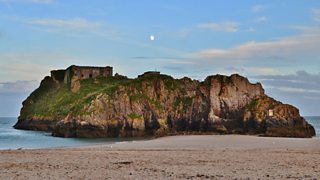Visitors to Tenby will almost certainly have seen St Catherine's Island, the small tidal rock which sits at the 'town end' of South Beach. The stretch of sand in front of the island is actually called Castle Beach and is sometimes known as the Catterns. It hardly matters – it’s the old Victorian fort on top of the island that most people seem to notice.
In April 2014 the island was opened to the public for the first time in 40 years and, hopefully, the fort will also soon be available for visits. If so, it will provide Tenby with yet another major tourist attraction.
The island is a limestone outcrop, riddled with tiny caves. It stands, at its highest point, 25 metres high and is just over 200 metres in length and 60 metres wide. The invisible part of the island – that area around the outcrop that lies beneath the water – has been designated a Site of Special Scientific Interest.

St Catherine's Island and Fort. Copyright Paula J James
St Catherine’s Island (or St Catherine’s Rock as it is sometimes called) was once owned by Jasper Tudor, the uncle of Henry VII and the man, perhaps more than any other, who helped the young Henry to the throne of England. Jasper was Earl of Pembroke at the time but, as happened with many 'crown lands', the island eventually passed into the ownership of the Tenby Corporation.
The island had little use or value to the Corporation. You could not really build houses on it and by the 1850s it was inhabited solely by a flock of sure-footed sheep. These wild and agile creatures would roam over the rocky terrain of the island, wandering in and out of the ruins of the old chapel which until 1867 was the only building on the rock.
The creation of a fort on top of the island was part of the defensive network of forts and gun towers built around the British coast in the mid-Victorian period. They were the brainchild of Viscount Palmerston, the Prime Minister, designed to protect Britain from invasion by the French. With Pembroke Dockyard located just 12 miles away, other examples of these forts can still be found in Milford Haven and in the town of Pembroke Dock.
However, by the time the forts were built the threat of invasion – and war with France – had passed. This meant that the defensive structures were obsolete even before they were built. Nevertheless, building continued and, as a result, the series of forts were quickly christened as 'Palmerston Follies'.
St Catherine’s Island was bought from Tenby Corporation by the Ordnance in 1866, for the grand sum of £800. Clearing the site began a year later, tall cranes being erected on top of the island in order to lift the massive granite blocks from the beach onto the construction site. The chief constructor was a local man, George Thomas who came from nearby Pembroke.

St Catherine's Island and Fort. Copyright George Lloyd licensed under Creative Commons
The fort was designed and built in a traditional rectangular shape, not unlike the fort on Thorne Island at the mouth of Milford Haven and cost £40,000 to construct – not bad for a building that was clearly not needed any more!
By 1870 building work was finished but, with the danger of invasion long past, the guns - which were an essential part of any defensive structure like this - were not installed until 1886. The fort was designed to hold six seven-inch muzzle-loading weapons and also had three platforms that could mount massive nine inch guns.
The approach to the fort was over a drawbridge and the thick granite walls gave the whole place a sense of security and power. If any enemy had come within range the fort on St Catherine’s Island would have been a very powerful nut to crack. In the event, no enemy ever came.
The fort was de-commissioned in 1907 and was sold to a local family. They turned the building into a private house – although you cannot help thinking that, while it retained a certain grandeur, the fort would have been a very cold and draughty place to live.
During World War One it was garrisoned by units of the Royal Artillery. The Royal Marines also stationed a detachment there and, according to some sources, so did the Royal Flying Corps. In World War Two the island was requisitioned by the army and an anti-aircraft battery was installed in front of the fort.
After 1945 the island passed, once again, into private hands. In an enterprising and unusual move, in 1968 a zoo was opened on the island and in the fort. The zoo and its animals lasted for just over 10 years before being relocated in 1979. Since then the fort has remained empty.
St Catherine’s Island and its fort are an essential part of the Tenby topography. They have a fascinating history and, hopefully, will continue to be of value and interest to the tourist for many years to come.
